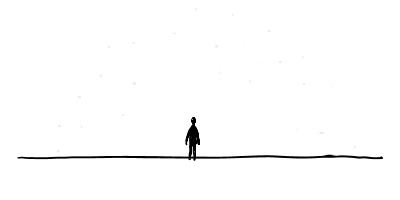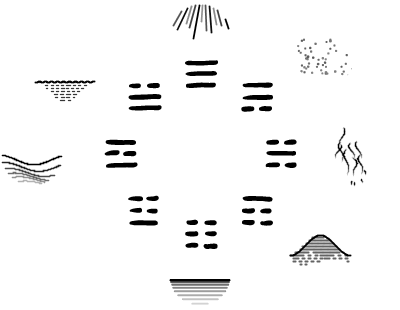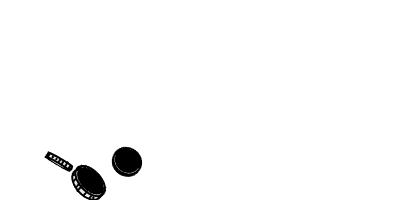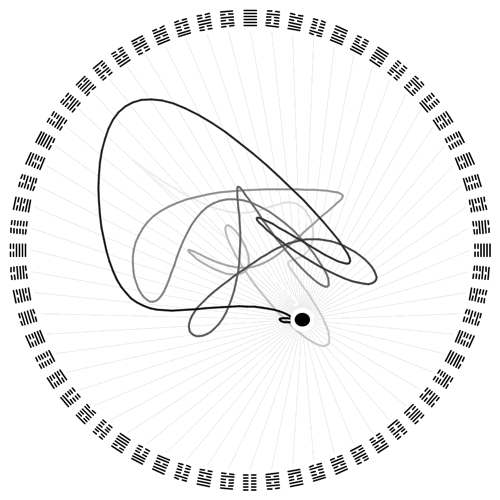The Book of Change
Navigate life with this ancient Chinese book.
The Yijing 易經 or “Book of Change” is one of China’s oldest books and a corner stone of Chinese philosophy. It tells us how to understand change, how to find out what kind of change we are in right now, and how to deal with it.

It is also very strange.
Let’s see how it works!
What is change?
The underlying principle of the Yijing is that there is order in change — not just senseless movement. In its purest form change is the alternation between two extremes.

We can observe this principle in the change between day and night, the change of the seasons, but also in our personal experience of good and bad times.

In Chinese philosophy this idea of change as alternation between two extremes is expressed in the concept of Yin 陰 and Yang 陽.

It is important to understand that we can’t have one without the other. Just like the night is part of the day, death is part of life and bad times are part of good times. We can’t stop the inevitable change, the alternation between the opposites.
But we can learn to live with it.
How? The Yijing offers three steps: a map of the changes, a method to identify our current situation, and advice to act accordingly.
1. A map of changes
The principle of alternating extremes can be expressed in a broken and a straight line.

We can apply such a pair of Yin and Yang to opposites like the one between heaven and earth.

If we add a second line then we can introduce another pair, for instance the opposite of fire and water.


Add a third line and we get four different pairs. These are the eight basic trigrams of the Yijing: heaven, earth, fire, water, mountain, lake, thunder, and wind.

If we double each trigram we get 64 different possible hexagrams. These 64 signs represent 64 situations of change. They are a map of our existence.
2. So where are we?
If you are a rationalist person like me then the next part won’t come easy. To find out in which situation you currently are, you toss coins — or count sticks. We can assign Yin and Yang to each side of a coin. If we use three coins we get four possible meanings for each toss: Yin, Yang, weak Yin and weak Yang.

You could also count the stalks of the yarrow plant in a complicated ritual. But let’s not get caught up in the details here. The point is: We use randomness to come up with a hexagram, look it up in the book and find out in which life situation we currently are.
Is this blunt superstition? Maybe. But Carl Gustav Jung serves as a good example of how to approach the oracle of the Yijing with an open mind. He wondered how randomness could offer meaningful connections between our psyche and the external world, even without a direct link of cause and effect.
3. What should we do now?
Whether we toss coins or use good old rational introspection to figure out where we are in our lives — in a third step the Yijing offers advice.

Each of the 64 situations of change has been extended with commentaries by brilliant minds like Confucius 孔子. Over the centuries this book has matured into a rich collection of wisdom, philosophical thoughts, and poetic motifs.
A dynamic book
Using today’s digital media we are accustomed to get information which is perfectly suited to our interests and needs. The format of the Yijing does something similar. It is also based on a binary code — Yin and Yang — to structure the changes in our lives and find out about our fate which keeps oscillating between opposite poles.

The Yijing is a dynamic book about the questions we have in an ever-changing world and a treasure of inspirational wisdom.
If you want to dig deeper
- Cary F Baynes, I Ching or Book of Changes
- Richard Wilhelm, I Ging. Das Buch der Wandlungen (German version)
- Hellmut Wilhelm & Richard Wilhelm, Understanding the I Ching: The Wilhelm Lectures on the Book of Changes
Before you go
If you enjoyed this article, then subscribe to my mailing list to receive more animated stories!
Thanks
Marianne from Stockholm
Very interesting to read this explanation of the Yijing (same as the Tao Te Ching? ) I was puzzled about the symbols in a book I have but this explains it well, though I’d like to read more. How drawing makes you think” TED talk is great and I have watched it 3 times now as I have started to paint music now using graphic symbols I design.
Great perspective to i-ching and great ilustration, thanks for the inspirational sharing
I did not know I would be ‘lead’ to perspective on the IChing, from a TedTalk on drawing! I love it!
My German mother, born 100 years ago this coming November, always had her ‘falling apart’ Book of Changes, with her. She was very careful when she ‘cast the coins’ for another. Most times she would decline. A few times during my Life, Mother advised me “it is a time to be extra Mindful”. I always heeded this advisement.
Thank you for Being here!
Denise In Raleigh
OMG!!!! I have watched you TedTalk over 20 times and I have utilized it within my high school art course I teach. So I was curious about the man….which led me here. And the first entry is about the I Ching – a tool I have studied and used for the past 20 years…..I’m even more intrigued. WHO ARE YOU, Ralph???
Love your posts!
Very interesting and inspiring Ted talk and I love this I ching thing.
Great & Inspirational TED talk i ever heard. Wish to see more videos.
Oh my god I love this. I’ve been trying to explain the Yijing so many times, but never quite manage to make it comprehensive. This — this is amazing. Thank you.
Hmm, Our life looks like a pendulum that moves from yin to yang, vise versa. What a philosophy.
I am do happy to have come across this beautiful piece. Movement made this text do alive! I love it.
Lucy
Thank you I am fascinated and you have stimulated me to draw and think differently. I have to come back to this again and again. Your TED talk was amazing – I took notes and have started my December journal from a renewed angle – after a large blank this year. Thank you.
Amanda